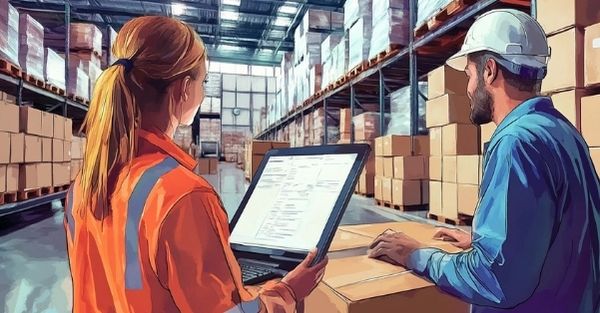
The demand for supply chain innovation that enhances efficiency, flexibility, and visibility continues to grow. From AI-driven inventory tracking to labor-free picking solutions and cloud-based warehouse management, the future of logistics is filled with innovation. We recently spoke with some of the industry’s brightest minds to explore the advancements set to redefine warehouse operations in 2025.
Meet our Partners
- Bridget Nelson, Product Manager at Gather AI
- Steve Simmerman, Vice President of Global Alliances at Locus Robotics
- Brian Schuckle, Director of Strategic Accounts at SVT Robotics
- John Sidell, Principal and Co-Founder at New Course Group
Supply Chain Innovation #1: AI-Powered Vision: A New Era of Warehouse Visibility
Tracking inventory in real time has long been a challenge, but computer vision and AI are changing the game. Bridget Nelson, Product Manager at Gather AI, shared an update on MHE Vision, an AI-driven MHE camera system designed to revolutionize real-time material handling visibility and warehouse efficiency.
MHE Vision integrates with Material Handling Equipment, such as forklifts, auto pickers, pallet trucks, etc. to automatically track every pallet movement – including loading, unloading, putaway, and replenishment.
“MHE Vision can track the movement of goods through all workflows in your warehouse,” Nelson explains. “This means real-time insights into inventory, reducing errors, and creating a more responsive supply chain.”
As businesses struggle with labor shortages and increasing customer expectations, AI-powered vision solutions ensure every warehouse transaction is visible, measurable, and optimized for efficiency.
Supply Chain Innovation #2: Labor-Free Picking: The Future of Warehouse Robotics
Robotics have become an integral part of supply chain operations, and Locus Robotics is taking automation to the next level with Array, the first AI-driven, fully automated order fulfillment system designed to significantly reduce labor dependency and improve efficiency in warehouses.
According to Steve Simmerman, Vice President of Global Alliances at Locus Robotics, “This is literally labor-free picking. The bot, equipped with a robotic arm, moves through the aisle, retrieves items, and sorts them into outbound totes—all without human intervention. It can run 24/7, 365 days a year.”
Locus Array eliminates manual work in order fulfillment, making operations faster, more accurate, and more cost-effective. It combines AI-powered automation, double-deep tote storage, and seamless integration with Locus Robotics’ existing technology to help warehouses optimize efficiency.
The bottom line? Autonomous picking solutions will continue to gain traction in 2025, offering warehouses greater flexibility while addressing ongoing labor challenges.
Supply Chain Innovation #3: Cloud-Based Control: Unlocking a Unified Warehouse Network
As supply chains become more interconnected, real-time visibility across multiple facilities is critical. That’s why SVT has launched a new cloud-based portal for its SOFTBOT Platform, providing IT and operations teams with a central control hub for monitoring and managing automation across multiple sites.
As automation adoption continues to grow, companies need a centralized way to monitor and troubleshoot their technology. “With our cloud portal, clients can go into one place and see all their warehouse sites,” explained Brian Schuckle, Director of Strategic Accounts at SVT Robotics. “They can drill down into specific locations and analyze data in real time, giving them full operational control.”
Managing automation at scale has historically been complex, but new cloud-based applications will make it significantly easier.
Supply Chain Innovation #4: The Rise of Flexible Automation Over Traditional Steel
Historically, warehouse automation was dominated by large-scale AS/RS (Automated Storage and Retrieval Systems) and conveyor-based solutions. But that landscape is shifting, as companies opt for flexible, autonomous solutions instead.
John Sidell, Principal and Co-Founder of New Course Group, stated, “Cloud-based applications and robotics are allowing companies to deploy automation faster and more cost-effectively.’ And, Jim Barnes, CEO and Chief Customer and People Officer at enVista, pointed to a blurring of the lines between traditional steel-based automation and robotics. “We’re seeing traditional steel manufacturers like Honeywell moving into autonomous cobots, while new players like GreyOrange and Hai Robotics are scaling up in the robotics space. This convergence of traditional metal and collaborative robotics is driving major changes in warehouse automation.”
In 2025, we’ll continue to see more hybrid solutions, where robotics enhance existing warehouse infrastructure rather than replacing it entirely.
What’s Next for the Supply Chain?
The supply chain of 2025 will be defined by AI-driven visibility, autonomous fulfillment, and cloud-powered decision-making. As companies face increasing pressures around labor, efficiency, and speed, these innovations will become essential for staying competitive. The future of supply chain management is here—and it’s more intelligent, automated, and adaptable than ever before. Get more expert insights here.


